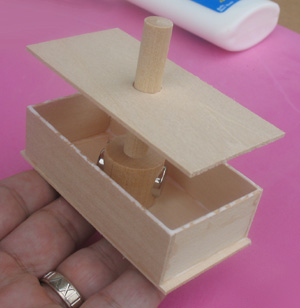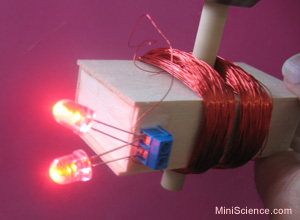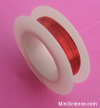
Wooden
Electric Generator
(Standard)
New Smaller Version
Introduction:
An electric generator is a
device that converts mechanical energy to electrical energy. In a
generator, a moving magnet will push the free electrons in a conductor
back and forth. Movements of electrons along a conductor are called
electricity. Since in this type of electricity electrons swing back and
forth, we also call it alternative electricity and show it with symbol
AC. Home electricity is an AC electricity with frequency of about 50
Hertz; In other words, electrons swing back and fort 50 times per
second.
In a wooden generator, the
main structure is made of wood. The only non wooden parts are the magnet and
the wire.
The instructions bellow will help you make
a working wooden electric generator using the materials available in the
standard wooden generator kit of MiniScience.com.
Please verify and compare the content of
your kit with the list below. This kit is updated as of March 1st, 2009.
(Instructions for the classic
version are available HERE)
The new content include:
- Two bottom and top wood boards,
(90mm x 43mm x 1mm with a 10mm hole in the center)
- Two large side boards (83mm x 23mm
x 1mm)
- Two small side boards (40mm x 23mm
x 1mm)
- Rotor (A wood dowel with a hole in
the center to hold the magnet)
- Strong magnet
- Sand Paper
- Two LED lamps that may be used
separately or together.
- Terminal Block to connect the
wires and LED lamps.
- Spool of 200 feet magnet wire
|
 |
Construction procedures:
- Place the bottom board on a
flat surface.
- Glue one edge of a large side
board and place it vertically along one of the long sides on the
bottom board. Center it.
- Glue two edges of a small side
board and place it vertically along one of the short sides of
the bottom board so that it will also connect to the previous
long side and support it.
- Glue two edges of the second
small side board and place it vertically along the other short
side of the bottom board. This also will support the long side.
|
 |
- Apply glue to the long edge of
the second long side board and vertical edges of the previous
two small side boards. Now place the second long board on the
remaining long edge of the bottom board.
- Align all the vertical side
boards while the glue is still wet. Make sure the side walls of
the box form a perfect rectangle. Apply additional glue if
needed and then let the glue to dry.
|
 |
- Insert the magnet in the hole
of the rotor wood dowel. Since the diameter of the magnet and
the diameter of the hole are both 13mm (1/2 inch), it should
make a perfect fit. However, in some cases you may need to use a
sand paper to enlarge the hole or use some glue to secure the
magnet in place. Small amounts of glue are always recommended so
that the magnet cannot move later.
|
 |
- Make sure the box glue is
dried and then insert the rotor in the hole of the bottom board.
Now the magnet is completely in the box.
|
 |
- Apply glue to the top edges of
the box.
|
 |
- Place the top board while the
rotor wood dowel goes through its hole. Lower the top board
until it touches the glued edges and complete (close) the box.
|
 |
- While the glue is still wet,
make necessary alignment of the edges. Apply additional glue if
needed.
- Make sure the wood dowel rotor
can spin freely.
- Let the glue dry.
|
 |
- Now that the box is ready, you
can start wrapping the magnet wire.
- Leave about 15 cm (6 inch) of
the magnet wire and then proceed to wrap the magnet wire around
the box. (Be sure to begin wrapping at least 15cm in from the
beginning of the wire or else you will run into a problem later
on. You will need this end as one of your contact wires.)
- Wrap the wire at least 230
turns in one side of the wood dowel, then continue to wrap on
the other side of the wood dowel until you finish the wire.
(Note that the direction of wrapping wire
does not change and you will not cut the wire at any time.)
|
 |
- Carefully insert the terminal
block in one end of the box. (The pins can enter the wood by
some force and jiggling). Apply some glue under the terminal
block and let it dry.
- Use a sandpaper to remove the
insulation from 3 centimeters of each end of the wire.
(Insulation is in the form of clear or red paint covering the
wire)
- Bend and twist the bare wire
ends to give it some volume. Then insert each end in one of the
holes of the terminal block. Temporarily use masking tape or
rubber band to hold the wires in place.
|
 |
- Insert the pins of one LED
lamp into the holes of the same terminal block. (Each pin will
enter one hole).
- Optionally insert the second
LED lamp so that the short pin of the second LED and the long
pin of the first LED will enter the same hole. Make sure that
the crossing pins do not touch each other.
- Tighten the screws on the
terminal block so that the wires and LED lamps are held tightly.
|
 |
- Test your wooden generator by
spinning the wood dowel rotor as fast as you can. The LED lamps
must blink. If you cannot get a light, check all the connections
and try again.
|
 |
The important materials in this kit are
shown bellow.

Strong Magnet |

200 feet magnet Wire |

Terminal Block |

Wood Parts |

Sand Paper |

LED lamps |
Easy
Light The materials in this kit
are specifically selected to increase the success rate of this project and
make it easier to light up the LED lamps while spinning the wood dowel by
hand.
| The Kit Contains all the
wood parts cut to size with necessary holes, the insulated copper wire
known as magnet wire, the super strong magnet, the LED lamps, the
terminal block and the sand paper.
In addition to this online
instruction and the above materials, you will need some wood glue or
white glue.
Simple Electric Circuit
Part#KITWG
|
 |
You may order wooden
generator science set online. All parts are cut to size and ready to
use.
Wood glue, masking tape and sand
paper are not included. Additional wooden parts may be included.
|





















